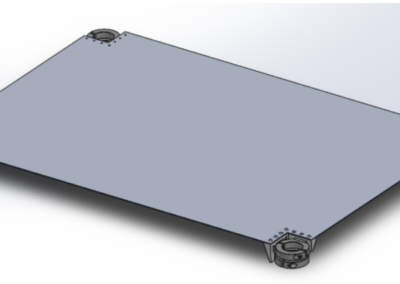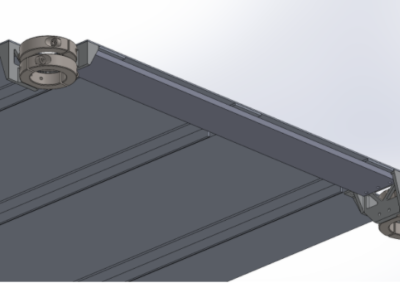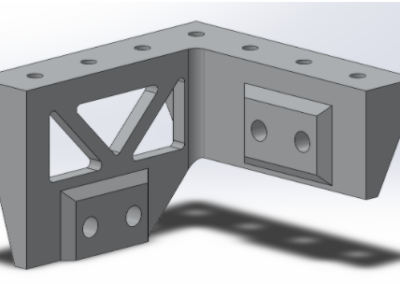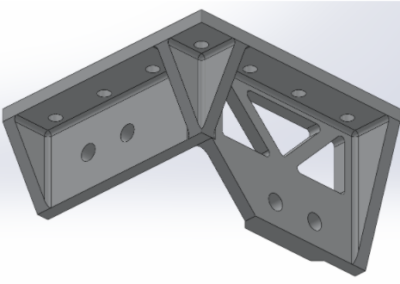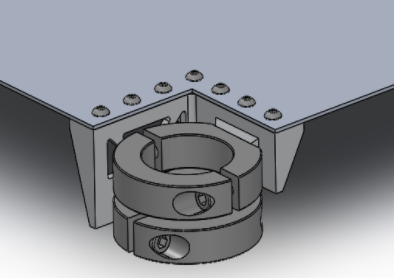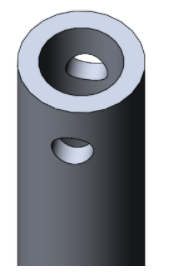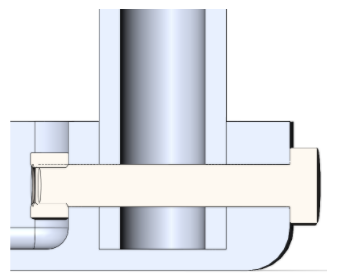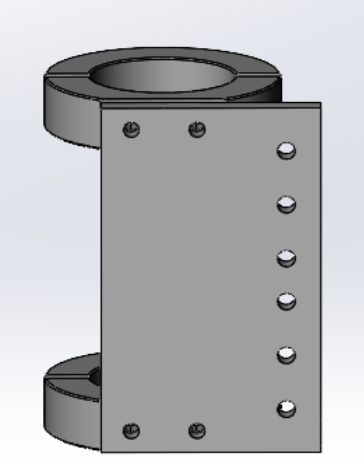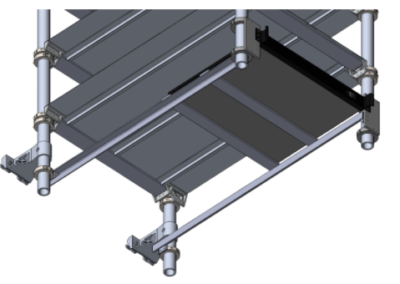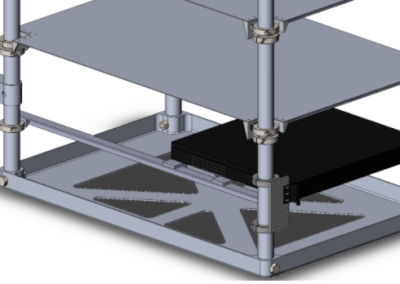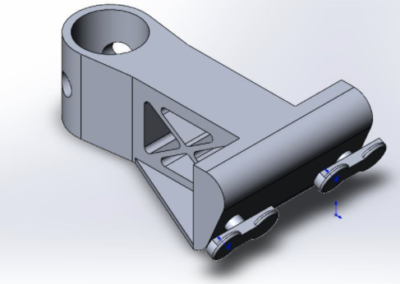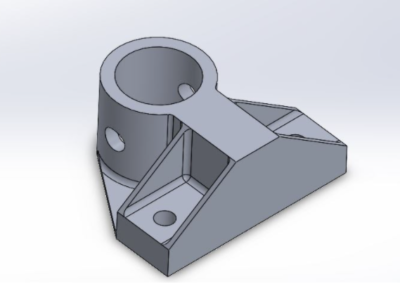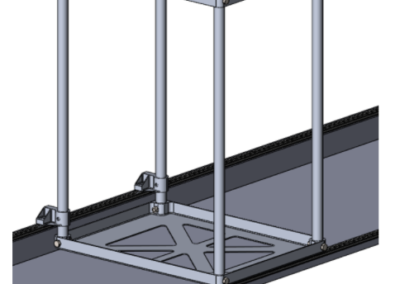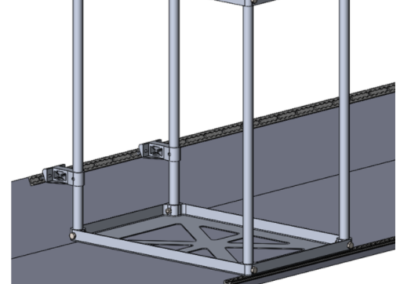Sierra Nevada Corporation, Aircraft Modular Equipment Rack, Team 1
Overview
The Sierra Nevada Corporation is well know in industry for their advanced aerospace engineering expertise and ability to provide customer focused technologies for aerospace applications. As such, they host a variety of programs that utilize equipment racks installed on a multitude of different platforms. Each platform has its own specific requirements, which ends up in each program designing a platform-specific equipment rack. Sierra Nevada sponsored our team to deliver a baseline modular equipment rack design that could accommodate a common set of requirements as well as platform and program specific requirements.
Our team designed a modular equipment rack that could be configured to either the Dornier 328 or Bombardier Dash 8 Q200 aircraft. The modular equipment rack was designed to accommodate a variety of electrical equipment and was designed with infinite vertical adjustability therefore eliminating the need for interval mounting. To add, the modular equipment rack allows for shelves to be easily inserted and removed without interfering with other equipment on the structure therefore eliminating unnecessary steps during maintenance. As a result of our solution significant cost and schedule savings could be realized for Sierra Nevada Corporation, eliminating the need for future project specific equipment rack redesigns.
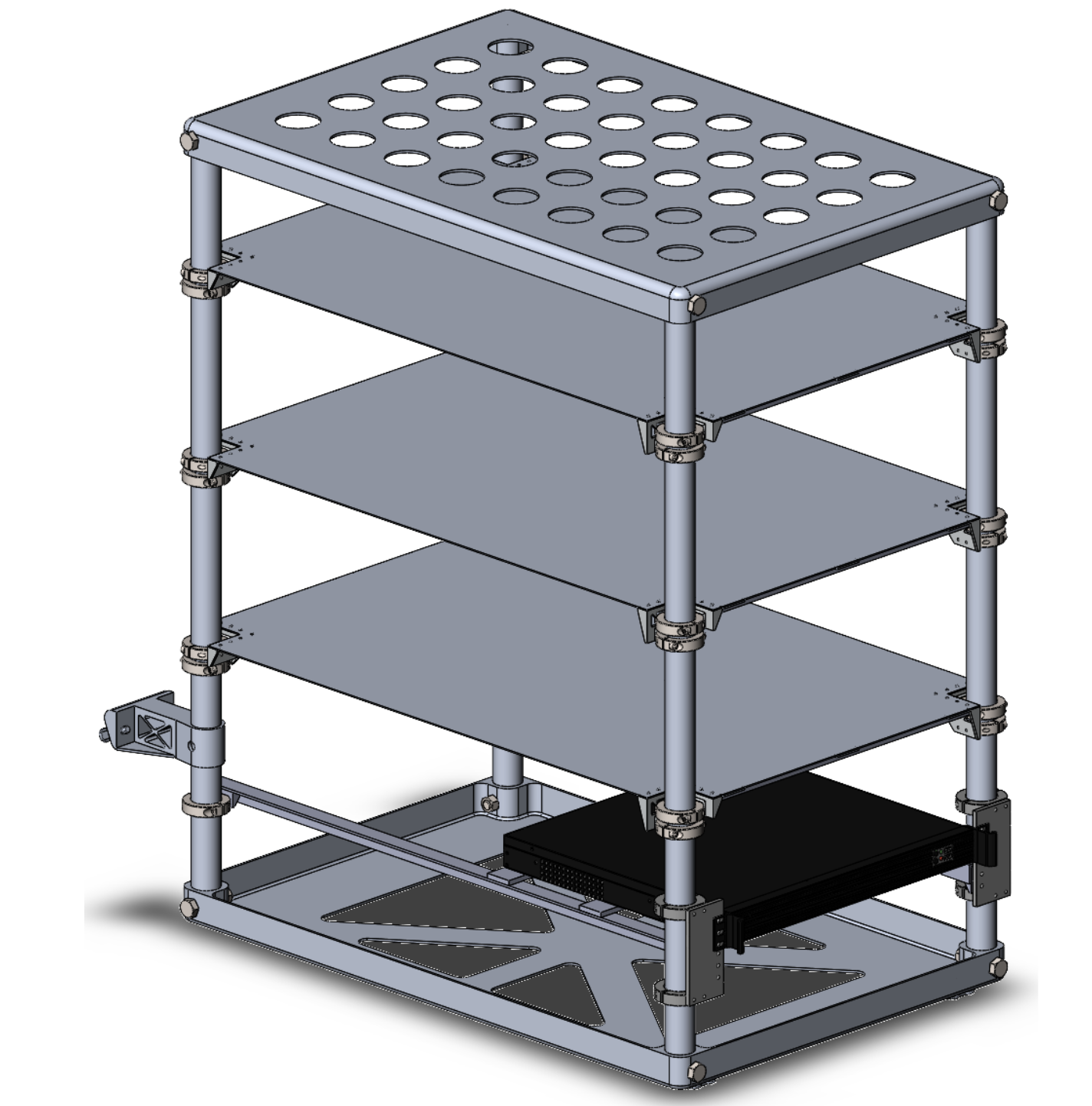
Live Zoom Chat
Use the link below to join us live from 8:00 – 10:30 a.m. on April 29th.
Please use passcode: 472469
Or iPhone one-tap: 16699006833,95844255793# or 12532158782,95844255793#
Or Telephone:
Dial: +1 669 900 6833 (US Toll) or +1 253 215 8782 (US Toll)
Meeting ID: 958 4425 5793
International numbers available: https://mines.zoom.us/u/adXjEYUniN
Or a H.323/SIP room system:
H.323: 162.255.37.11 (US West) or 162.255.36.11 (US East)
Meeting ID: 958 4425 5793
Password: 472469
Team Members
- Clark Kuehl
- Maia Menefee
- Jacob White
- William Broughton
- Aubrey Bradford
- Rolando Botello
- Mitchell Long
- Dylan Shapiro
The Client
- Sierra Nevada Corporation (SNC)
Acknowledgements
Project Advisor: Jim Beseda
SNC Technical Advisors:
- Andy Hardy – Director of Engineering – IAS
- Jared McPherson
- Chris Williamson
In the early stages of the design process, client meetings, research into FAA regulations, and a survey of the two aircrafts that we are interfacing with were completed to help define the system requirements. During the aircraft survey we were able to see first hand some of the challenges that we might need to overcome including space constraints, various mounting interfaces, and working environment. By taking measurements of the inside of the planes and asking some questions to individuals who actually work on the planes, we were able to get a better understanding of where to start with our design. We were also able to see some equipment racks and learn more about the issues that exist with the current designs that are being used.
Concept exploration in the fall semester led to four potential rack designs and the idea generation for custom wall mounts for the rack in the aircraft. Following our Preliminary Design Review the chosen design was the friction clamp method as it was the most novel design that fulfilled the client requirements of “infinite” adjustability. To ensure the continued success of the design the team followed a compliance tracking sheet that contained the regulations implemented by the FAA. A stoplight requirements tracking sheet was also generated with the guidance of our Sierra Nevada technical advisors to show the progress of all deliverables required of the team.
Once the friction clamp method was chosen as the design that would be pursued, an iterative design process was implemented. For this design process a part would be created and continually changed as more analysis was performed on it and feedback from the sponsor SNC was collected. This process was particularly important in the weight reduction of the design. Areas that had an unnecessarily large margin of safety were reduced in material to lower the part weight while still maintaining the requisite safety.
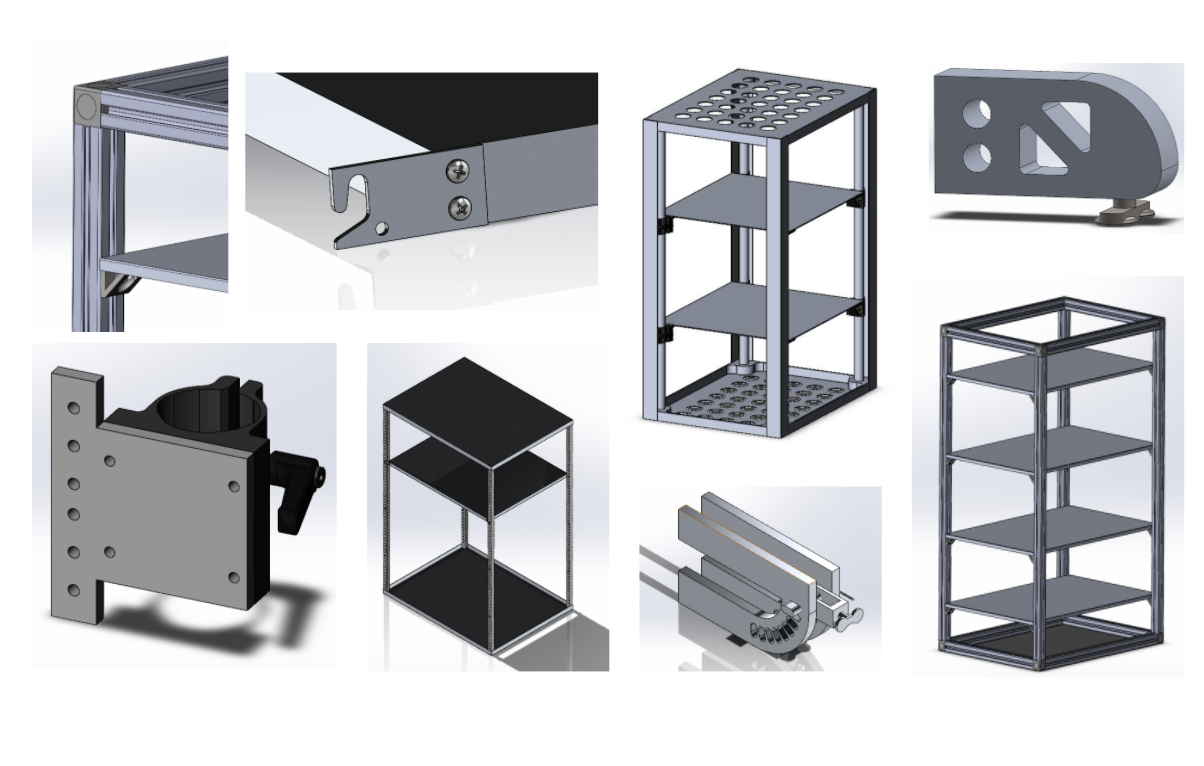

Design Solution
Rack structure:
The structure of our equipment rack was designed around the circular vertical stanchions in each corner, that were made from 6061-T6 aluminum extrusions with a Type III hardcoat anodized surface. The fit of the stanchions into the base and top plate will be a sliding for ease of assembly and will include a laser etched pattern to help align the shelves during assembly and adjustments. Due to the different seat track alignments in the planes, there will be a depth difference between the two racks.
Shelves:
Four shelves reinforced with support underneath were designed to accommodate a variety of electrical equipment. To achieve “infinite” adjustability, these shelves were designed to interface with the stanchions using two-piece shaft collars. Face mounts were also designed to accommodate electrical equipment that does not have mounting points on the bottom-side.
Custom Mounting:
In order for the rack to be installed into a variety of different aircraft, we designed custom mounting devices, specifically designed for a couple different seat track rail arrangements, to interface between the stanchions of the rack and the seat track rails on the aircraft. These mounts are secured to the rack stanchions with sliding fits and a bolt through the stanchion. Two mounting studs secure the custom mounts, and thus the rack, to the aircraft seat track rails. The mounts were designed to reduce weight while maintaining strength, weighing approximately a pound each. SNC would need to design and manufacture additional mounts if they were to install our rack design in different aircraft with different seat track rail configurations.
Next Steps
As for next steps, it is recommended for SNC to conduct a vibration and load analysis for the custom-made two-piece shaft collars. These shaft collars provide “infinite” adjustability and ease of assembly therefore, should be verified for use before progressing with other equipment rack testing. To manufacture these shaft collars, two potential manufacturers have been identified: Stafford and Ruland. It is not expected for these shaft collars to be proprietary therefore could be outsourced to other manufacturers.
It will also be important for SNC to verify all the documentation work to ensure compliance with the Federal Aviation Administration. Various reports completed by the team included a flammability assessment, instructions for continued airworthiness, a structure substantiation report, and a few others specific to our design. These documents were very new to our team and slightly beyond the scope of the Capstone Design class, so it will require SNC to take these on further and perfect them if the project were to continue.
Meet the Team
Clark Kuehl
 Clark Kuehl is a graduating senior who will receive his B.S. in Mechanical Engineering with an Area of Emphasis in Aerospace Engineering in May 2021. After graduation, Clark has accepted an offer for a full-time position as a Mechanical Engineer at Lawrence Livermore National Laboratory in Livermore, California. As a member of this team Clark was able to use his previous design-oriented internship experiences to contribute to the success of this project. Clark helped to develop the selected design in the early stages of the course as well as refine it further as a member of the structure subsystem team.
Clark Kuehl is a graduating senior who will receive his B.S. in Mechanical Engineering with an Area of Emphasis in Aerospace Engineering in May 2021. After graduation, Clark has accepted an offer for a full-time position as a Mechanical Engineer at Lawrence Livermore National Laboratory in Livermore, California. As a member of this team Clark was able to use his previous design-oriented internship experiences to contribute to the success of this project. Clark helped to develop the selected design in the early stages of the course as well as refine it further as a member of the structure subsystem team.
Maia Menefee
 Maia Menefee is a graduating senior who will receive a B.S. in Mechanical Engineering and a minor in Culture, Creativity, and Communications. Following graduation in May 2021, Maia has accepted an internship as a Facilities Engineer at Chevron and will return to CSM to pursue an M.S. in Advanced Energy Systems. For this project, Maia was able to utilize her project management and engineering experience learned in industry to ensure the success of this project. She contributed heavily towards the design and implementation of the shelving subsystem and functioned as the communications lead throughout the course always ensuring clear and consistent client communication.
Maia Menefee is a graduating senior who will receive a B.S. in Mechanical Engineering and a minor in Culture, Creativity, and Communications. Following graduation in May 2021, Maia has accepted an internship as a Facilities Engineer at Chevron and will return to CSM to pursue an M.S. in Advanced Energy Systems. For this project, Maia was able to utilize her project management and engineering experience learned in industry to ensure the success of this project. She contributed heavily towards the design and implementation of the shelving subsystem and functioned as the communications lead throughout the course always ensuring clear and consistent client communication.
Jacob White
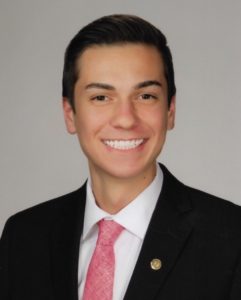 Jacob White is a graduating senior who will receive his B.S. in Mechanical Engineering with a minor in Computer Science in May 2021. After graduation, Jacob has accepted an offer for a full-time position as a Systems Engineer at Northrop Grumman in Roy, Utah. Jacob, throughout this two semester course, assisted with the structure team to develop the optimal design in addition to maintaining budget reports and purchase orders.
Jacob White is a graduating senior who will receive his B.S. in Mechanical Engineering with a minor in Computer Science in May 2021. After graduation, Jacob has accepted an offer for a full-time position as a Systems Engineer at Northrop Grumman in Roy, Utah. Jacob, throughout this two semester course, assisted with the structure team to develop the optimal design in addition to maintaining budget reports and purchase orders.
William Broughton
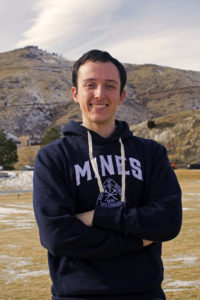
William Broughton is a graduating senior who will receive his B.S. in Mechanical Engineering in May 2021. After graduation William has accepted an offer as a Mechanical Engineering Intern at Northrop Grumman in Brigham City, Utah and will return to the Colorado School of Mines to pursue a master’s degree in Mechanical Engineering the following Fall. While working on this project William contributed to the design as a member of the structural subsystem and worked closely with the mounting subsystem on several calculations.
LinkedIn:
Aubrey Bradford
 Aubrey Bradford is a graduating senior in the mechanical engineering department, with an area of interest in additive manufacturing. Aubrey has yet to secure a job, but is hopeful of finding a career in the aerospace or automotive industries. As a member of ths senior design team, Aubrey used his design and additive manufacturing skills to develop and iterate multiple, design crucial parts to fit the clients requirements as part of the shelf and equipment mounting subsystem team.
Aubrey Bradford is a graduating senior in the mechanical engineering department, with an area of interest in additive manufacturing. Aubrey has yet to secure a job, but is hopeful of finding a career in the aerospace or automotive industries. As a member of ths senior design team, Aubrey used his design and additive manufacturing skills to develop and iterate multiple, design crucial parts to fit the clients requirements as part of the shelf and equipment mounting subsystem team.
Rolando Botello

Rolando Botello is a graduating senior who will receive his B.S. in Mechanical Engineering with a Minor in Robotic and Intelligent Systems in May 2021. Post-graduation, Rolando has accepted a full-time offer with Procter & Gamble as a Mechanical Engineer in Cape Girardeau, MO. As a member of this team, Rolando utilized his industry experience to contribute to the success of this project. Rolando helped design and verify various components of the equipment rack and ensured that communication between the team and the client was effective.
LinkedIn: https://www.linkedin.com/in/rbotello98/
Mitchell Long
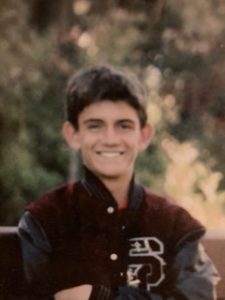
Mitchell Long is a graduating senior who will receive his B.S. in Mechanical Engineering in May 2021. After graduation, Mitchell has accepted an offer for a part-time position as a Systems Engineer at Ball Aerospace in Boulder, Colorado. Throughout this two semester course, Mitchell assisted with the mounts team to develop and validate the optimal design for the custom seat track mounts on each plane.
Dylan Shapiro

Dylan Shapiro is a graduating senior who will receive his B.S. in Mechanical engineering in May 2021. After graduation, Dylan plans to get his M.S. in Mechanical engineering at the Colorado School of Mines. Dylan, throughout this two semester course, assisted with the mount team to develop the mounting system for our rack and also he has assistant the structure team to get a better overall understanding of the stresses analysis of the rack.

